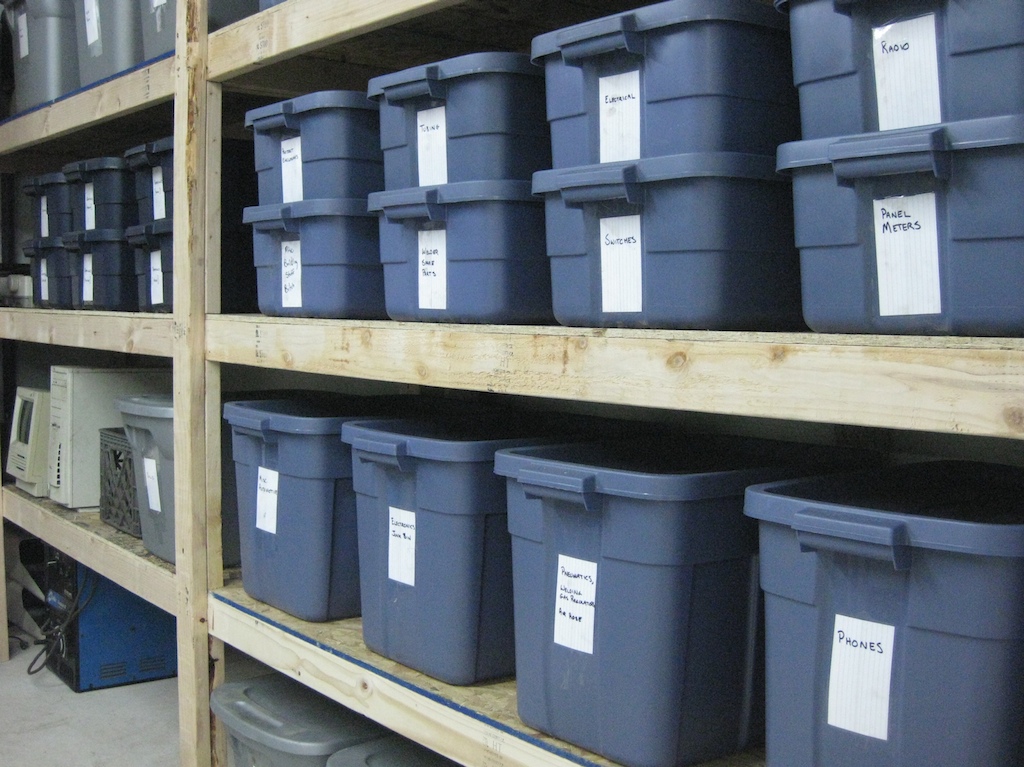

We may earn revenue from the products available on this page and participate in affiliate programs. Learn more ›
With the move to the new shop, I’ve been forced to revisit our approach to storage and organization. The first area to get the treatment was the stash of valves, miscellaneous bearings, telephone parts, solenoids, and a few thousand other small to mid-sized parts. At this point in time, it looks like Rubbermaid is my savior.
As the collection of “stuff” has grown over the years, the methods of organization have evolved. Open shelves with piles of junk quickly failed for the obvious reasons—it is hard to keep things of odd shapes and sizes piled on the shelves and everything is exposed to all of the dust and mess in the shop. After a certain weight threshold, shelves seem to collapse. Later, I used coffee cans and surplus wooden bins (some of which I still keep as mementos from the venerable and sadly expired Fertik’s electronics surplus store in Philadelphia). The coffee cans and boxes first lived on shelves, and later migrated into a mix of shelving and salvaged filing cabinets. This was better because things were better compartmentalized, labeled, and protected, but still had its shortcomings. One major issue was the amount of effort involved in re-allocating storage. If the pipe fittings drawer became overcrowded, for example, I would logically try to annex the next drawer in the filing cabinet. Typically, however, that drawer would already be filled, necessitating further reorganization. While such operations did give me a chance to become reacquainted with our junk and to periodically purge the collection, for the most part they just burned valuable time.
In the new shop, we have a whole room for storage. (Cue chorus of angels.) We built the cheap 2-by-4 and plywood equivalent of pallet shelving and populated it with two sizes of Rubbermaid “Roughneck” totes. Lighter but bulky items go in the bigger totes (18-gallon size) and smaller and/or heavier items end up in the smaller ones (10-gallon size). There are still a few classes of items in storage that would be better served by a storage cabinet with divided drawers such as the Stanley Vidmar series of cabinets, but for things like my collection of Western Electric model 500 rotary phones and stash of surplus fabric, this is a great solution. The smaller size totes are of the same width and length and are just over half the height of the larger totes. As a result, one large tote or two smaller totes stacked will fit into approximately the same space, which simplified both the construction of the shelves and the organization of the bins.
Among the advantages of this system are a decent measure of protection from the surrounding elements, ease of re-ordering and re-organization, ease of expansion of the overall storage system, and my favorite: the ability to bring the totes to where they are needed around the shop. Secondary advantages include the ease with which these can be stacked on pallets and in trailers for transport. On occasion, we bring some of our contraptions to events, and the ease of loading and transport with these bins is unparalleled. I also expect to reap significant time savings in the next shop move.
There are still some disadvantages to this storage scheme. There is a significant amount of empty space being wasted in most of the containers, which is essentially by design; were they filled to the top, they would be very difficult to pick through. If we didn’t have a substantial amount of space devoted to storage, this solution would not fit our needs as well. The bins are also fairly expensive, especially considering the simplicity of their construction. I have been paying around $5 to $7 apiece.
I suspect we’ll continue with this mode of storage for some time to come for the items too bulky, plentiful, or infrequently accessed to merit placement in a storage cabinet closer to the center of the action in the shop. If I find a decently priced source of clear plastic totes that fit within the same size assumptions built into our shelving, I may gradually transition to those.
Whatever the situation in your shop, I recommend giving serious consideration to how this sort of plastic tote can help your organizational situation. In my next post on this topic, I’ll look at storage options to replace my filing cabinet filled with coffee cans full of sorted fasteners.